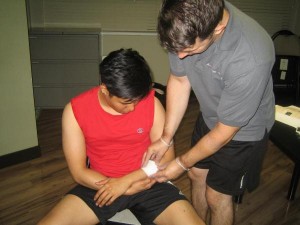Who could forget the portrayal of Michelle Pfeiffer, Halle Berry or Anne Hathaway as sexy, devious Catwoman? Catwoman is Batman’s arch nemesis turned lover that has cat-like skills and surprisingly, a good heart. These feline friends are actually very lovable and popular. Factually, cats are most common household pets in the United States. There are approximately 86.4 million cats owned just in the US, marginally greater than the number of 78.2 million of dogs owned. Although dogs are said to be more common in the US households, 52% of cat owners own more than one cat, greatly increasing the total number of owned cats (The Human Society of the United States 2012).
Cats don’t often scratch and/ or bite people, more so their owners. They only bite when upset, frightened or when their kittens are threatened. Hence, it is often better to leave them alone. The sharp teeth of cats cause much pain to the victim. Children are the most common victims of cat bites.
Animal bites are highly susceptible to infection, nonetheless, proper first aid brought about by first aid training, can help decrease the probabilities of sustaining an infection. Moreover, proper first aid may prevent scarring which usually occurs as an outcome of the tissue damage and infection.
As soon as the victim is bitten, safety is the foremost priority. Move either the
Before initiating treatment on the victim, wash hands and put on protective gear, such as gloves, if available to reduce chances of infection. Most cat bites and scratches are superficial, thus requiring basic first aid to stop the bleeding. Direct pressure should be applied to the wound until bleeding ceases. If there is severe blood loss, immediately call for emergency medical assistance while continuing to apply pressure.
To clean and disinfect the wound, make use of clean water and soap to clean the scratches and bites for a minimum of 15 minutes. To disinfect the wound, use antiseptics or antibiotic ointments. This will avoid infections, quicken the healing time and aid in minimizing scarring. Consult a physician at all times regardless of how superficial the wounds are. This is because cat bites and scratches oftentimes lead to infection. Some signs of infection include redness, heat, swelling and pus from the wound. If the cat is unknown and is questionable to have rabies, it is important to immediately seek for medical assistance.
Fresh antibiotic creams should be applied every so often and wounds should be covered to prevent infection. Make use of bandages or gauze to avoid the dirt from getting trapped in the wound. The wound should be checked regularly for signs of infection before bandage or gauze is replaced.
It is highly recommended for cat owners of people who live with cats to know basic first aid treatment for cat-caused injuries. First aid courses teaches basic instructions for life-threatening situations.
